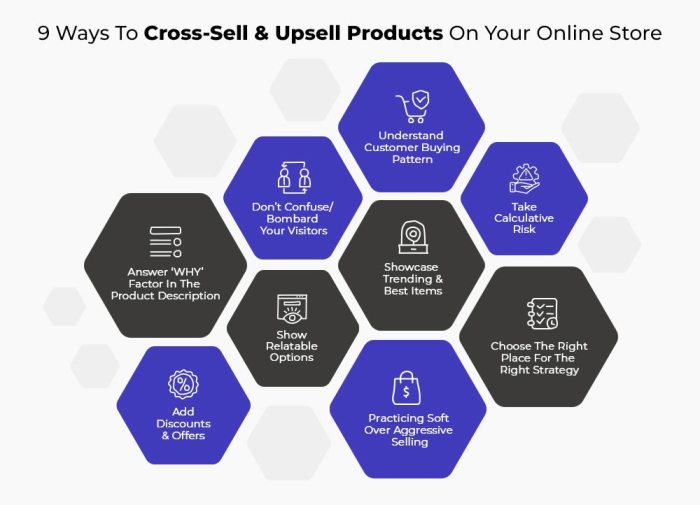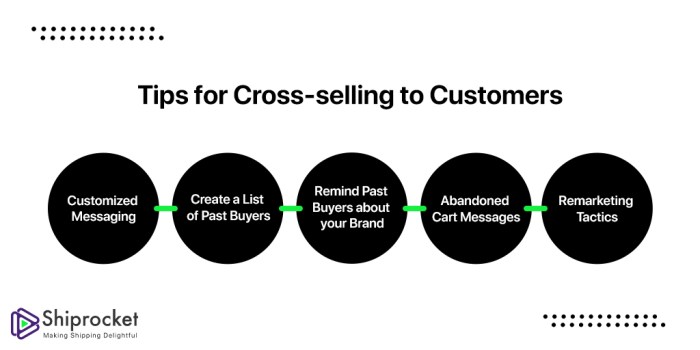Yo, diving into Cross-Selling Techniques, we’re about to drop some knowledge on how to level up your sales game. Get ready to learn the art of upselling like a pro.
In this guide, we’ll break down the key strategies and tactics businesses use to increase revenue through cross-selling.
Introduction to Cross-Selling Techniques
Cross-selling is a sales technique where a company promotes additional products or services to existing customers. It involves offering related or complementary items that enhance the customer’s original purchase.
For businesses, cross-selling is crucial for increasing revenue and customer loyalty. By suggesting relevant products or services, companies can maximize the value of each customer interaction and build stronger relationships with their client base.
Examples of Successful Cross-Selling Strategies
- In the retail industry, a clothing store may cross-sell accessories like belts or shoes to customers purchasing a dress.
- In the technology sector, a company selling smartphones may offer screen protectors or cases as add-ons to the main product.
- In the banking industry, financial institutions often cross-sell credit cards or insurance products to account holders.
Difference Between Cross-Selling and Upselling
Cross-selling differs from upselling in that upselling involves convincing a customer to buy a more expensive version of the product they are already considering, while cross-selling focuses on offering additional items that complement the original purchase.
Understanding Customer Behavior for Cross-Selling
When it comes to cross-selling, understanding customer behavior is crucial for success. By analyzing consumer psychology and preferences, businesses can effectively identify opportunities to offer additional products or services to their customers.Customer segmentation plays a key role in enhancing cross-selling effectiveness. By dividing customers into different groups based on characteristics such as demographics, buying behavior, or preferences, businesses can tailor their cross-selling strategies to meet the specific needs of each segment.One way to identify cross-selling opportunities based on customer behavior is to analyze purchase history and browsing patterns.
By tracking what customers have bought in the past or what products they have shown interest in, businesses can predict what additional products or services they may be interested in purchasing.Data analytics also plays a significant role in understanding customer preferences for cross-selling. By analyzing data on customer interactions, feedback, and purchase history, businesses can gain valuable insights into what products or services are likely to appeal to specific customers.
This data-driven approach can help businesses personalize their cross-selling efforts and increase the chances of success.
The Role of Data Analytics in Understanding Customer Preferences
Data analytics is a powerful tool that businesses can use to gain insights into customer preferences and behavior. By analyzing data on customer interactions, feedback, and purchase history, businesses can identify patterns and trends that can help them understand what products or services customers are likely to be interested in. This data-driven approach allows businesses to personalize their cross-selling efforts and offer targeted recommendations to customers, increasing the likelihood of a successful cross-sell.
Effective Cross-Selling Techniques

Cross-selling is a powerful strategy to increase revenue and improve customer satisfaction. By utilizing different techniques such as bundling, product recommendations, and add-ons, businesses can maximize their sales opportunities and enhance the overall customer experience.
Bundling, Cross-Selling Techniques
Bundling involves offering complementary products or services together as a package deal. This technique not only increases the average order value but also encourages customers to purchase more items than they initially intended. For example, a fast-food restaurant may offer a combo meal with a burger, fries, and a drink at a discounted price, enticing customers to buy the whole package instead of just a burger.
Product Recommendations
Product recommendations leverage data and algorithms to suggest additional items that are relevant to a customer’s purchase. By personalizing recommendations based on previous purchases or browsing behavior, businesses can effectively cross-sell products that align with the customer’s interests. For instance, e-commerce platforms often display “Customers who bought this item also bought…” recommendations to encourage customers to explore related products.
Add-Ons
Add-ons are extra products or services that complement the main purchase. By highlighting the value and benefits of add-ons, businesses can entice customers to enhance their original purchase. For example, a car dealership may offer add-on services such as extended warranties, maintenance plans, or accessories to customize the vehicle, increasing the overall sale value.
Examples of Successful Cross-Selling Campaigns
Companies like Amazon, Netflix, and Starbucks have mastered the art of cross-selling through personalized recommendations and strategic bundling. These campaigns have significantly impacted their revenue streams and customer loyalty, showcasing the effectiveness of targeted cross-selling techniques.
Importance of Personalized Recommendations
Personalized recommendations play a crucial role in cross-selling by providing customers with relevant and tailored suggestions. By analyzing customer data and preferences, businesses can offer personalized recommendations that resonate with individual customers, leading to higher conversion rates and customer satisfaction.
Timing and Relevance in Cross-Selling Offers
The timing and relevance of cross-selling offers are key factors in driving successful conversions. By presenting cross-selling opportunities at the right moment in the customer journey and aligning them with the customer’s needs and interests, businesses can increase the likelihood of a successful cross-sell. Understanding when to offer additional products or services and ensuring their relevance to the customer’s current purchase are essential aspects of effective cross-selling strategies.
Implementing Cross-Selling Strategies: Cross-Selling Techniques

When it comes to implementing cross-selling strategies for a business, there are several key steps to consider in order to maximize success.
Developing a Cross-Selling Strategy
- Identify complementary products or services that can be cross-sold together.
- Analyze customer data to understand buying patterns and preferences.
- Create targeted cross-selling offers based on customer segments.
- Implement a structured approach to cross-selling across all sales channels.
Training Sales Teams for Effective Cross-Selling
- Provide comprehensive product training to sales teams to increase product knowledge.
- Teach sales teams how to identify cross-selling opportunities during customer interactions.
- Offer incentives or rewards for successful cross-selling efforts to motivate sales teams.
Role of Technology in Automating Cross-Selling Processes
- Utilize customer relationship management (CRM) software to track customer interactions and preferences.
- Implement recommendation engines on e-commerce platforms to suggest complementary products.
- Use data analytics to identify cross-selling opportunities and personalize recommendations.
Measuring Success and Optimizing Strategies
- Track key performance indicators (KPIs) such as cross-selling conversion rates and average order value.
- Analyze customer feedback and adjust cross-selling strategies based on customer response.
- Continuously test and optimize cross-selling offers to improve effectiveness over time.
